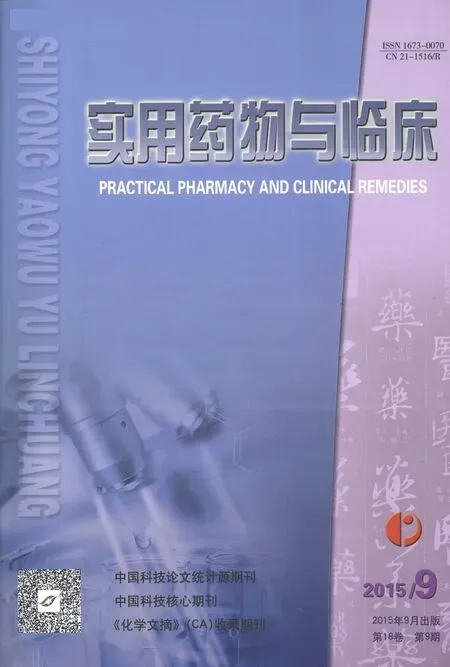维生素D与TLR、Tregs、Th17在类风湿性关节炎发病机制中的作用研究进展
杨滨州,张 育
0 引言
类风湿性关节炎(RA)是一种以慢性增殖性滑膜炎为主要临床表现的自身免疫性疾病。增殖的滑膜形成血管翳最终侵袭下层的软骨和骨,造成关节破坏,是造成我国劳动力丧失和人口致残的重要原因。在RA滑膜炎的发生与发展中,单核/巨噬细胞、树突状细胞、T淋巴细胞等免疫活性细胞及其产生的细胞因子起到了关键的作用。现有的研究证实上述免疫活性细胞均表达维生素D受体(VDR)。维生素D(VD)作为维持人体钙、磷平衡的重要调节物质,在体内经过肝肾两次羟化,最终转化成1,25(OH)VD3,即活性维生素 D,发挥其生理作用。VD与骨代谢的关系早已被人熟知,而VD与RA、系统性红斑狼疮(SLE)、系统性硬化病(SSc)、自身免疫性肝炎(AIH)、糖尿病(DM)等多种自身免疫性疾病的相关性近年来才引起人们的广泛注意。现认为活性VD通过与VDR的相互作用,调控这些免疫活性细胞DNA的转录,进而改变其免疫反应性,参与包括RA在内的自身免疫性疾病的发生与发展。
1 VD与Toll样受体
RA的发病机制尚不十分明确,现有理论认为,其是感染因子与遗传因素共同作用的结果。Toll样受体(TLR)作为一种感染因子模式识别受体,广泛分布于单核 -巨噬细胞、树突状细胞(DC)、T淋巴细胞、B淋巴细胞、NK细胞等多种免疫细胞,在抗原递呈过程中有着极其重要的作用,是固有免疫与特异性免疫的桥梁。而活性VD能够通过影响TLR表达改变免疫进程,在阻遏RA的发生与发展中起到积极作用。
TLR基因的多态性研究证实了TLR与RA的相关性,一项Meta分析显示,TLR单核苷酸多态性与亚洲和中东人群RA相关,TLR9(rs187084)多态性在土耳其RA患者中有更高的基因频率,TLR8(rs5741883)则与风湿因子水平呈正相关,但在欧洲人群中,TLR4(rs4986790)则与RA的发病率无关[1]。另外一项Meta分析也显示,TLR-5和TLR-7的单核苷酸多态性与高加索人群RA的发病率无关[2]。
活性VD对TLR的影响可能通过如下两个机制产生对RA的保护作用。一是通过影响TLR抑制促炎症因子释放。RA患者关节病理改变的多种细胞成分包括巨噬细胞样的A型细胞、成纤维细胞样的B型细胞、滑膜基质细胞、内衬下的炎性淋巴细胞以及新生的血管内皮细胞均表达TLR受体[3]。并且这些TLR受体阳性细胞数量与RA滑膜炎的严重程度呈正相关,其中 TLR1、TLR2、TLR3、TLR5阳性细胞与炎症严重程度的相关性更为明显[3]。通过阻断 TLR3、7、8、9 的信号传导,氟西汀和西酞普兰(两者都是选择性的5-羟色胺再摄取抑制剂,SSRIs)能够改善小鼠胶原诱导关节炎(CIA)模型的临床症状[4]。Ultaigh 等[5]发现,使用 Pam3CSK激动 TLR1、TLR2,能够促进RA患者滑膜体外培养组织分泌肿瘤坏死因子α(TNF-α)、白介素1β(IL-1β)、白介素 6(IL-6)、干扰素γ(IFN-γ)等多种炎症因子,并且这种促炎症因子分泌作用能被OPN301(一种TLR2抗体)所阻断。Drexler等[6]也报道在RA患者滑膜细胞中过表达Toll/白介素1受体8(TIR-8,一种IL-1R和TLR阻断剂)能够抑制多种细胞炎性因子的释放,在酵母多糖和胶原抗体诱导的小鼠关节炎模型(ZIA、CAIA)中显示出强大的保护作用。1,25(OH)VD3能够促进外周血单核细胞(PMBCs)下调TLR2、4、9的表达,减少 TLR9介导的 IL-6分泌[7]。一项体内实验发现,在VD缺乏的个体中,脂多糖(LPS,一种 TLR4激动剂)和 Pam3Cys(TLR2激动剂)能够促进TNF和IL-6的大量分泌,提升机体的炎症反应性,而在VD充足的个体中,这种促进TNF和IL-6分泌的作用受到显著抑制[8]。二是通过TLR影响RA相关细胞的分化、成熟和免疫反应性。研究发现,Pam3CSK(TLR1、TLR2激动剂)能够通过Tie2信号传导通路上调RA患者滑膜体外培养组织中微血管内皮细胞(HMVEC)促血管生长蛋白2(Ang2)的表达,促进血管形成,增加滑膜的侵袭性[9]。1,25(OH)VD3能与LPS(TLR4激动剂)共同诱导DC细胞分泌IL-6、8、10,抑制 LPS诱导的 IL-12分泌和 DC细胞快速成熟,研究还发现,LPS能够增加DC细胞VDR的表达,说明活性VD可能是免疫反馈调节中极其重要的生物活性因子[10]。
2 维生素D与调节性T细胞(Tregs)和辅助性T细胞17(Th17)
近20年来许多研究者都发表了关于VD影响T淋巴细胞分化、成熟和功能的报道。传统观念认为Th1细胞异常激活,启动的Th1相关免疫异常是T淋巴细胞致RA发病的重要机制,而近年来对Tregs和Th17的研究进一步深化了对T淋巴细胞与RA关系的认识,同时也证实了VD在这一过程中所起到的重要作用。
2.1 Tregs Tregs是一组具有免疫调节作用的T细胞亚群,以高表达Foxp3分子为特征,可分为天然产生的自然调节性T细胞(nTreg)和刺激因素下产生的诱导性调节性T细胞(iTreg)。Tregs通过膜表面分子与其他免疫细胞接触或者释放某些细胞因子发挥其免疫调节作用,对免疫耐受有着极为重要的意义,其数量和功能的异常和包括RA在内的多种自身免疫性疾病有着密切的关系。RA患者PBMS中表达Foxp3的细胞亚群显著减少[11]。Estrada-Capetillo 等[12]发现,RA 患者外周血来源的DC诱导T细胞向Foxp3阳性Tregs分化的能力存在缺陷。而通过增加Tregs数量和增强Tregs免疫调节功能,阿伐他汀能减轻RA患者的炎症反应,降低血沉速度和C反应蛋白,减轻病情的严重程度[13]。Barbera 等[14]也发现,使用一种被称做APL1的T细胞抗原表位激活剂可以激活Tregs并在RA患者中诱导效应T细胞的凋亡。
而口服活性VD能够增加Foxp3阳性细胞数量[15]。随后更多的研究发现,在多种免疫系统过度激活的病理条件下,VD与Tregs的数量呈正相关,并且对免疫系统的过度激活具有抑制作用[16-17]。一种活性 VD类似物能够抑制 IFN-γ、IL-4等细胞因子分泌,促进T细胞向Tregs亚群分化,抑制效应T细胞的增殖和活化[18]。
1,25(OH)VD3诱导的调节性T细胞抑制自身免疫的作用依赖于Foxp3的表达,研究发现,FOXP3基因+1714到+2554的非编码保守区域是VDR反应元件(VDRE),活性VD能够通过VDR与该区域相互作用,增强FOXP3启动子活性,促进 Foxp3表达,起到抑制自身免疫的作用[19]。
2.2 Th17 Th17是一种分泌IL-17的CD4+T细胞亚群,能够促进多种细胞分泌IL-1、IL-6、TNF-α等促炎症因子。研究发现,RA患者的Th17细胞数量高于OA患者,病情活动患者的Th17细胞数量高于不活动的患者,并与DAS28、ESR和CRP正相关[20],而来自RA的DC具有更强的诱导 T细胞向Th17亚群分化的能力[12]。阿达木单抗则能通过抑制Th17的反应性起到治疗RA的作用[21]。一项最新的研究发现,Th17细胞免疫反应相关基因多态性与RA发病的性别特点有相关性[22]。这些都说明了Th17在RA发生与发展中起到了重要作用。
活性VD能够抑制Th17的反应性,减弱小鼠对感染因子的敏感性[23]。在 RA 患者中,1,25(OH)VD3减少 PBMCs中 IL-17A和 IFN-γ的表达,通过抑制 IL-17A、IL-17F、TNF-α,减少 IL-17A+记忆T细胞的数量,起到对关节的保护作用[24]。
1,25(OH)VD3减少Th17数量,抑制其功能的作用途径一是通过VDR竞争性抑制“活化T细胞核因子(NFAT)”与DNA的结合,阻止hIL-17A启动子招募组蛋白去乙酰化酶(HDAC),阻止mIL-17A启动子募集Runt相关转录因子1(Runx1)来抑制IL-17A的表达,进而阻止CD4+T细胞向Th17亚群分化[25]。二是通过 VDR受体诱导C/EBP Homologous蛋白(CHOP)表达,在翻译水平而不是转录水平减少Th17相关细胞因子的表达,进而抑制Th17的功能[26]。
3 小结
自从上世纪80年代大量的流行病学调查证实了VD与RA的相关性以来,围绕VD的作用机制,研究者们进行了大量的工作。其中TLR部分的研究表明,VD的活性形式能够影响TLR相关信号通路,影响RA的发生与发展。活性VD能够改变RA相关细胞中TLR的表达水平,TLR的激活又可以反过来影响VDR的表达,这说明活性VD可能在免疫功能的反馈调节中起到关键作用,对于免疫反应的“度”有着重要意义。VD并不是一个免疫抑制剂,而是一个免疫调节剂,VD的活性形式能通过增强TLR信号传导途径,修复HIV感染者巨噬细胞受到结核分枝杆菌刺激时分泌TNF的能力[27]。这从另一个侧面说明了VD的作用是把体内的免疫反应维持在一个合理的水平,平衡免疫耐受和免疫防御,而不仅仅是通过抑制免疫发挥作用。通过VD机制的研究有助于改变RA治疗中免疫抑制一家独大的情况。非糖尿病RA患者中肽聚糖诱导单核细胞TLR2上调增加了患者对胰岛素的抵抗性[28]。提示RA患者的糖脂代谢异常不仅仅是应用糖皮质激素的结果,也有可能是疾病本身的一部分。VD及其活性形式与Tregs和Th17细胞的研究对RA的发生是Th1和Th2功能失衡的主流观点提出了挑战,这充分说明了RA发病机制的复杂性,对疾病始动环节的认识还需要更多的努力。总而言之,VD在RA中显示了强大的保护功能,目前面临的问题是如何将VD对多种RA相关细胞的作用机制整合起来,从分子和基因水平弄清RA发病机制的主线。相信通过进一步的研究,VD一定会在RA的预防与治疗中发挥更为重要的作用。
[1] Lee YH,Bae SC,Song GG.Meta-analysis demonstrates association between TLR polymorphisms and rheumatoid arthritis[J].Genet Mol Res,2013,12(1):328-334.
[2] Coenen MJ,Enevold C,Barrera P,et al.Genetic variants in toll-like receptors are not associated with rheumatoid arthritis susceptibility or anti-tumour necrosis factor treatment outcome[J].PLoS One,2010,5(12):e14326.
[3] Takakubo Y,Tamaki Y,Hirayama T,et al.Inflammatory immune cell responses and Toll-like receptor expression in synovial tissues in rheumatoid arthritis patients treated with biologics or DMARDs[J].Clin Rheumatol,2013,32(6):853-861.
[4] Sacre S,Medghalchi M,Gregory B,et al.Fluoxetine and citalopram exhibit potent antiinflammatory activity in human and murine models of rheumatoid arthritis and inhibit toll-like receptors[J].Arthritis Rheum,2010,62(3):683-693.
[5] Ultaigh SN,Saber TP,McCormick J,et al.Blockade of Tolllike receptor 2 prevents spontaneous cytokine release from rheumatoid arthritis ex vivo synovial explant cultures[J].Arthritis Res Ther,2011,13(1):R33.
[6] Drexler SK,Kong P,Inglis J,et al.SIGIRR/TIR-8 is an inhibitor of Toll-like receptor signaling in primary human cells and regulates inflammation in models of rheumatoid arthritis[J].Arthritis Rheum,2010,62(8):2249-2261.
[7] Dickie LJ,Church LD,Coulthard LR,et al.Vitamin D3 downregulates intracellular Toll-like receptor 9 expression and Toll-like receptor 9-induced IL-6 production in human monocytes[J].Rheumatology(Oxford),2010,49(8):1466-1471.
[8] Ojaimi S,Skinner NA,Strauss BJ,et al.Vitamin D deficiency impacts on expression of toll-like receptor-2 and cytokine profile:a pilot study[J].J Transl Med,2013,11:176.
[9] Saber T,Veale DJ,Balogh E,et al.Toll-like receptor 2 induced angiogenesis and invasion is mediated through the Tie2 signalling pathway in rheumatoid arthritis[J].PLoS One,2011,6(8):e23540.
[10] Brosbφl-Ravnborg A,Bundgaard B,Höllsberg P.Synergy between vitamin D(3)and Toll-like receptor agonists regulates human dendritic cell response during maturation[J].Clin Dev Immunol,2013,2013:807971.
[11] Matsuki F,Saegusa J,Miyamoto Y,et al.CD45RA-Foxp3(high)activated/effector regulatory T cells in the CCR7+CD45RA-CD27+CD28+central memory subset are decreased in peripheral blood from patients with rheumatoid arthritis[J].Biochem Biophys Res Commun,2013,438(4):778-783.
[12] Estrada-Capetillo L,Hernández-Castro B,Monsiváis-Urenda A,et al.Induction of Th17 lymphocytes and treg cells by monocyte-derived dendritic cells in patients with rheumatoid arthritis and systemic lupus erythematosus[J].Clin Dev Immunol,2013,2013:584303.
[13] Tang TT,Song Y,Ding YJ,et al.Atorvastatin upregulates regulatory T cells and reduces clinical disease activity in patients with rheumatoid arthritis[J].J Lipid Res,2011,52(5):1023-1032.
[14] Barberá A,Lorenzo N,Garrido G,et al.APL-1,an altered peptide ligand derived from human heat-shock protein 60,selectively induces apoptosis in activated CD4+CD25+T cells from peripheral blood of rheumatoid arthritispatients[J].Int Immunopharmacol,2013,17(4):1075-1083.
[15] Takeda M,Yamashita T,Sasaki N,et al.Oral administration of an active form of vitamin D3(calcitriol)decreases atherosclerosis in mice by inducing regulatory T cells and immature dendritic cells with tolerogenic functions[J].Arterioscler Thromb Vasc Biol,2010,30(12):2495-2503.
[16] Kalicki B,Lewicki S,Stankiewicz W,et al.Examination of correlation between vitamin D-3(25-OHD3)concentration and percentage of regulatory T lymphocytes(FoxP3)in children withallergy symptoms[J].Eur J Immunol,2013,38(1):70-75.
[17] Nashold FE,Nelson CD,Brown LM,et al.One calcitriol dose transiently increases Helios+FoxP3+T cells and ameliorates autoimmune demyelinating disease[J].J Neuroimmunol,2013,263(1-2):64-74.
[18] Baeke F,Korf H,Overbergh L,et al.The vitamin D analog,TX527,promotes a human CD4+CD25 high CD127 low regulatory T cell profile and induces a migratory signature specific for homing to sites of inflammation[J].J Immunol,2011,186(1):132-142.
[19] Kang SW,Kim SH,Lee N,et al.1,25-Dihyroxyvitamin D3 promotes FOXP3 expression via binding to vitamin D response elements in its conserved noncoding sequence region[J].J Immunol,2012,188(11):5276-5282.
[20] Kim J,Kang S,Kim J,et al.Elevated levels of T helper 17 cells are associated with disease activity in patients with rheumatoid arthritis[J].Ann Lab Med,2013,33(1):52-59.
[21] McGovern JL,Nguyen DX,Notley CA,et al.Th17 cells are restrained by Treg cells via the inhibition of interleukin-6 in patients with rheumatoid arthritis responding to anti-tumor necrosis factor antibody therapy[J].Arthritis Rheum,2012,64(10):3129-3138.
[22] Cáliz R,Canet LM,Lupiañez CB,et al.Gender-specific effects of genetic variants within Th1 and Th17 cell-mediated immune response genes on the risk of developing rheumatoid arthritis[J].PLoS One,2013,8(8):e72732.
[23] Ryz NR,Patterson SJ,Zhang Y,et al.Active vitamin D(1,25-dihydroxyvitamin D3)increases hostsusceptibility to Citrobacter rodentium by suppressing mucosal Th17 responses[J].Am J Physiol Gastrointest Liver Physiol,2012,303(12):G1299-G1311.
[24] Colin EM,Asmawidjaja PS,Van Hamburg JP,et al.1,25-dihydroxyvitamin D3 modulates Th17 polarization and interleukin-22 expression by memory T cells from patients with early rheumatoid arthritis[J].Arthritis Rheum,2010,62(1):132-142.
[25] Joshi S,Pantalena LC,Liu XK,et al.1,25-dihydroxyvitamin D(3)ameliorates Th17 autoimmunity via transcriptional modulation of interleukin-17A[J].Mol Cell Biol,2011,31(17):3653-3669.
[26] Chang SH,Chung Y,Dong C.Vitamin D suppresses Th17 cytokine production by inducing C/EBP homologous protein(CHOP)expression[J].J Biol Chem,2010,285(50):38751-38755.
[27] Anandaiah A,Sinha S,Bole M,et al.Vitamin D rescues impaired Mycobacterium tuberculosis-mediated tumor necrosis factor release in macrophages of HIV-seropositive individuals through an enhanced Toll-like receptor signaling pathway in vitro[J].Infect Immun,2013,81(1):2-10.
[28] Wang SW,Lin TM,Wang CH,et al.Increased toll-like receptor 2 expression in peptidoglycan-treated blood monocytes is associated with insulin resistance in patients with nondiabetic rheumatoid arthritis[J].Mediators Inflamm,2012,2012:690525.

